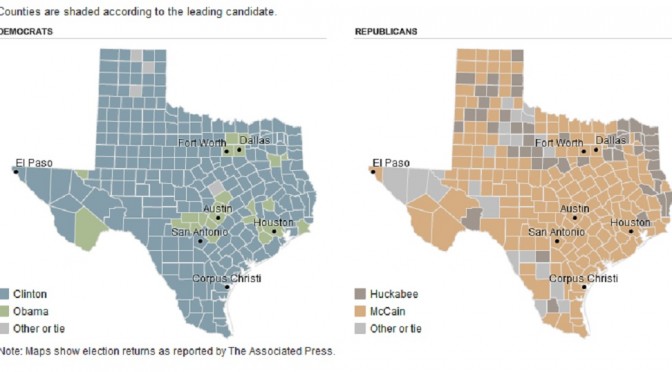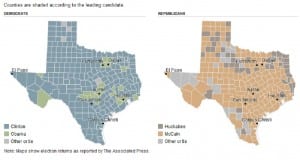If you know one thing about Battleground Texas, you know that their organization is taking on a huge task… re-make the voting electorate of the Lone Star State.
And as Ross Ramsey from the Texas Tribune writes, they’ve still got a long way to go to be able to do it.
Senate District 3, the most populous in the state in 2012, had 843,567 people; the least populous, Senate District 28, had 778,341. But look at the differences between populations of voting-age citizens: Senate District 3 had 603,385, while Senate District 6, now represented by Garcia, had 372,420. Even with identical percentage turnouts, one district would have more votes than the other.
That is the basis for one argument against the current districts in Texas, but it doesn’t account for the biggest disparity. Texans in one district do not seem to have the same urge to vote as their counterparts in other areas. Sen. Donna Campbell, R-New Braunfels, won in District 25, where 64.6 percent of the voting-age population cast ballots. Hers was one of three districts where more than 60 percent of adult residents voted. Garcia’s district, in that 2012 election, had a 37.1 percent turnout — one of three Senate districts with less than 40 percent.
The turnout numbers were low not just because of the low voting-age population — the number who got off their sofas to cast ballots in those districts was also abysmal. Those numbers offer a peek into the design of the political maps drawn by Republican legislators: The districts that turn out the most voters tend to favor Republicans by a wide margin in statewide elections, while the lowest turnouts are typically in Democratic districts.
Similarly large disparities show up on congressional and House maps.
Nick Lampson, a Democrat who ran in the 14th Congressional District, received 24,583 more votes in 2012 than Democrat Marc Veasey, but they were in different districts. Veasey went to Congress. Lampson went home. This is even more dramatic: Veasey won the 33rd Congressional District seat with 85,114 votes. His colleague Kevin Brady, R-The Woodlands, received 194,043 — more than twice as many.
Ramsey tries to be diplomatic here, but to be even more specific, Texas DEMOCRATS don’t vote. Congressman Veasey represents a heavily Democratic district, while Lampson competed in a district that leans GOP.
But Texas Democrats are definitely out there. We know this because we’ve seen them before. The 2008 Texas Primary garnered 2,868,454 Democrat voters to a mere 1,384,663 on the GOP side. Great candidates, in combination with the right message can drive Democrats to the polls, even in the Lone Star State. Hopefully Wendy Davis, Leticia Van de Putte and others will find that formula for the 2014 election.


Blog looks good and the writing is even better!